A good video game can get a lot of mileage out of its premise. Lots of games sell themselves on some sort of gameplay hook: It’s a stealth game… and you can fly! But how about old-school adventure games? They’re all story. To hook you, they’ve gotta start strong.
Broken Age, the new game from Tim Schafer’s Double Fine Production, starts strong. About a week ago I headed down to their San Francisco offices to chat with Schafer about his now-famous Kickstarted adventure game. He, Broken Age producer Greg Rice and I had a lengthy chat about the state of the project, and the reaction to the recent news that the game would be broken up and released in two parts in order to secure more funding to complete it. It was a cool interview; you can read the whole thing here.
While I was there, I also took the opportunity to check out a new section of the game itself. As Schafer narrated, Rice played through the opening chunk of one of the two playable characters’ story.
Broken Age plays very much like an old-school point-and-click adventure; Rice used a mouse to play, and everything was very streamlined. There’s a single icon for interaction — just hold the cursor over an object and click. The approach is simplified significantly from the “Push/Pull/Talk/Etc.” options in adventure games past. Characters walk where you click, and move along pre-ordained “rails,” just like in Monkey Island or Grim Fandango. You have an inventory. Sometimes you pick up objects from that inventory and click them on objects in the world. You get the idea: It’s an adventure game.
(The best little detail: The dialogue text matches the font and style of the classic Lucasarts adventure games so many of us grew up with: It’s coded differently for each character, and appears over their heads just so. It’s immediately recognisable, and I suspect that the majority of gamers will play this game with the subtitles on.)
But while I could give a point-by-point recitation of all the stuff I saw, I’d rather just focus on the coolest thing about the game: The narrative premise.
Broken Age tells the story of two characters, both of whom are 14-year-olds stuck between childhood and adulthood. There’s a girl named Vella and a boy named Shay. We’ve all become familiar with them — they’re the two characters sleeping in that Broken Age artwork that we’ve seen so often:
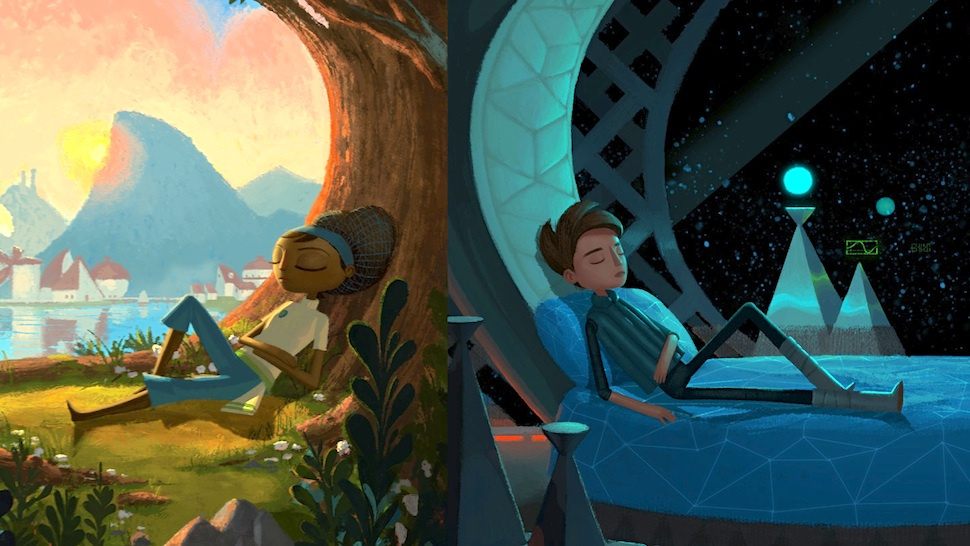
Players will be able to hop between controlling Shay and controlling Vella at any point in the game, which Schafer mentioned was a design decision inspired by Maniac Mansion. That ability to switch will also hopefully mitigate the “stuckness” that can result from tricky adventure game puzzles. If your brain needs a break after failing to figure out a particular puzzle, you can always flip to the other character.
The art is lovely — Broken Age looks a bit uncanny in motion, a sort of 2D-3D hybrid that almost feels like moving papercraft. It also reminded me of Ubisoft’s UbiArt Framework, a backend that helps some of their recent games to look so good. But what makes both Shay and Vella so interesting isn’t the characters themselves, it’s their circumstances.
In fact, rather that go into too much detail about the events I witnessed, I thought I’d just share the two premises. Here they are, starting with Vella.
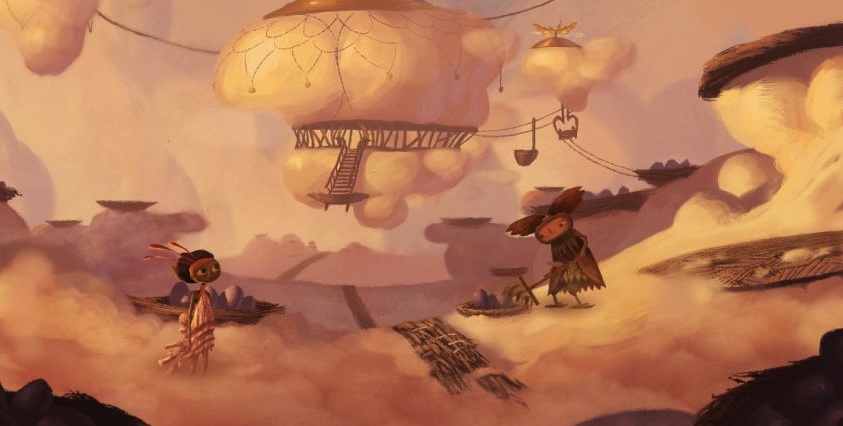
Vella is a young girl who lives in an idyllic, pastoral world. It’s all pastels and soft hues, just a really kind-looking, lovely place. And lucky Vella, she’s won the lottery!
When Schafer told me this, I jokingly asked him if the lottery was like the Shirley Jackson short story The Lottery, in which each year the townspeople in a small village select one of their own at random to be stoned to death, the better to ensure a bountiful harvest.
Schafer laughed and said, “It’s a little bit like that. Um, she’s been selected as a sacrifice to save her town. Every generation, this horrible monster comes…”
Sometimes it’s hard to tell when Schafer is kidding, so I asked if he was serious. And he was. So, that’s the setup of Vella’s storyline: Young girl is selected at random to be sacrificed to a monster to save her town, and decides that maybe this tradition is stupid, and maybe they should fight back against the monster. Makes you want to find out what happens next, no?
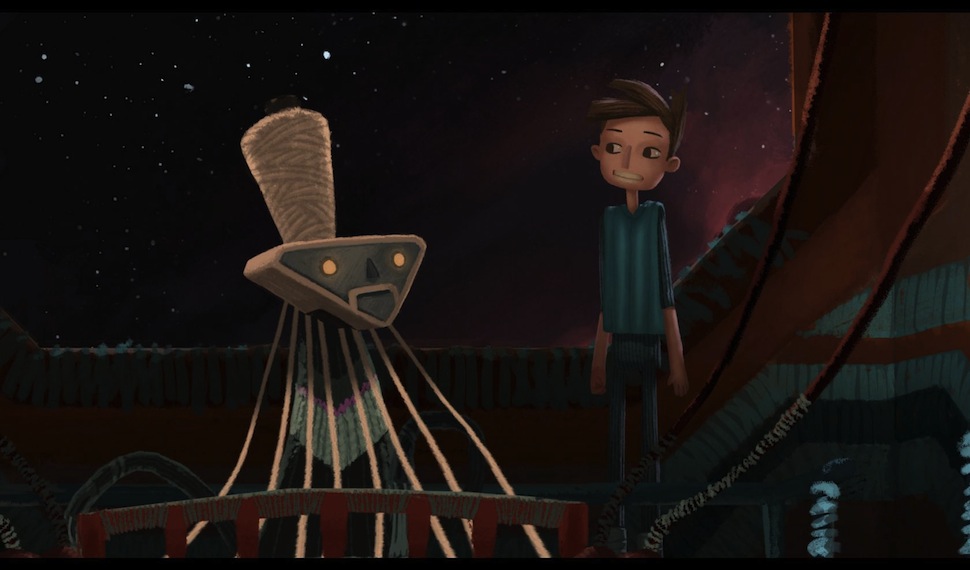
Shay, on the other hand, has a completely different setup. In fact, it’s not clear whether or not his storyline will directly intersect with Vella’s at all. Shay is alone on a spaceship, raised by a caring but smothering AI that acts as his mother figure. She looks, in a possible nod to The Truman Show, like the sun. (A fatherly male AI also appears; he looks like the moon, and comes out at night.) The motherly sun AI, as I immediately noticed, is voiced by FemShep herself, Jennifer Hale.
Schafer said that among his many influences were sci-fi stories like Duncan Jones’ Moon, which feature similarly philosophical, isolated narratives. Shay has been raised by robots seemingly from birth, alone on this spaceship, and he’s infantalized by everything around him. Toys and childish distractions litter the spaceship, and every day he goes on “missions” that are obviously fake, designed to keep him occupied. But from the very beginning, he’s clearly just a touch too old for all of this. He’s bored with his routine, and with the doting overseers that keep him hemmed in.
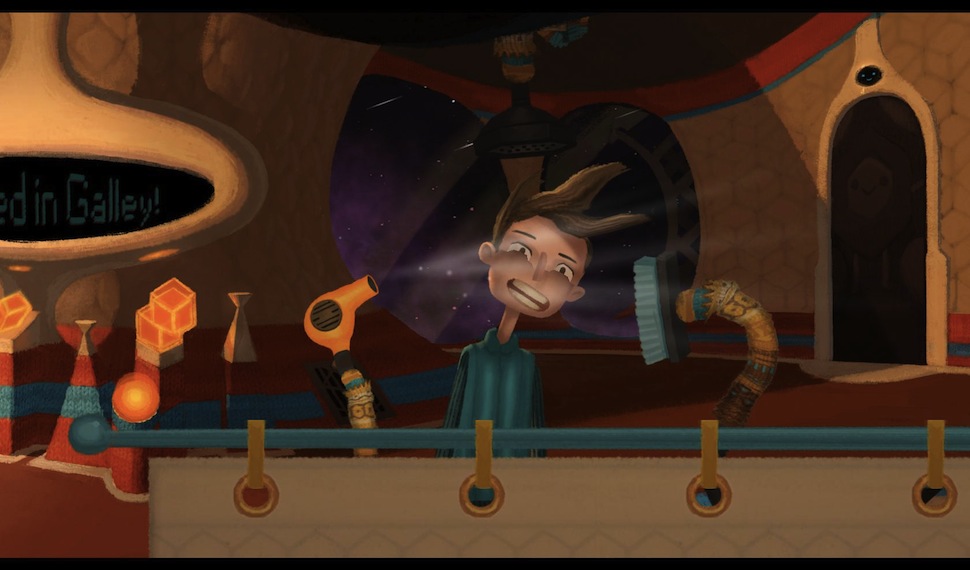
I don’t really think I need to share the particulars of what I saw of Shay’s early goings — he ate some cereal, got dressed, talked to the computer, and got into some goofy “adventures” that were clearly being staged by the spaceship AI. At some point, he begins to try to break out of his routine, with varying levels of success. Where he goes from there remains a mystery.
As I mentioned, it’s unclear whether the two characters’ stories are directly connected — I got a sense that there’s a small similarity between the worlds, but this could well be a Cloud Atlas-type situation where two characters live out two stories and only intersect thematically. (That or they could totally meet up and take down monsters together. Which would be fine by me.) At one point, Shay’s overseer AI mentioned something that sounded similar to Vella’s world, but it wasn’t clear whether it was a direct reference, or just an old myth.
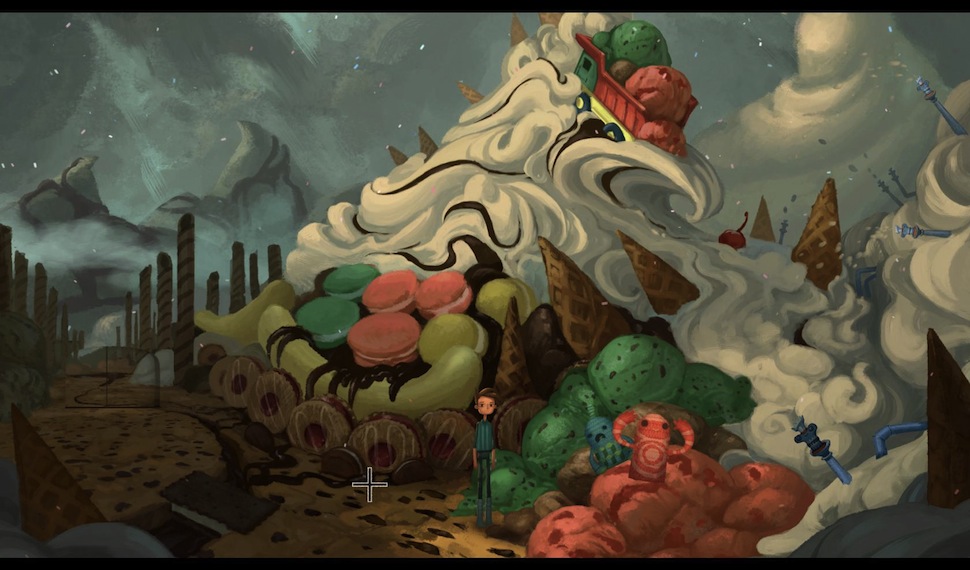
So often, a game’s premise is the gameplay, not the story. Because of that, it’s ok that the premise is often as simple as, “Aliens attack” or “Family member is kidnapped.” And it really is ok… for some games. But adventure games can’t really sell gameplay hooks — as Kotaku’s frequent guest board-game expert Quintin Smith once argued in a terrific adventure-game-centric letter series with Leigh Alexander, adventure games are kind of not on a level playing field with other types of games. Here’s Quinns:
People often hold up an adventure game, something like Grim Fandango, as the pinnacle of storytelling in games. Of course it is! It’s fucking cheating! It’s not trying to create a game, but offering riddles that link together its conversations and cutscenes. The point’n’click makes us laugh, it makes us cry, but it casts no shadow in the greater landscape of games.
And, yes, I get that argument. And while that doesn’t really diminish my enjoyment of adventure games, it does underline the fact that if an adventure game wants to succeed, it had better have a good story.
This adventure game’s story looks good. More than anything else about Broken Age, I was struck by how quickly both premises grabbed me, and how interested I was in finding out more. Adventure games need that one idea, one concept that hooks you. Broken Age has two, and I’m very much looking forward to seeing how they play out.
To contact the author of this post, write to kirk@kotaku.com or find him on Twitter @kirkhamilton.
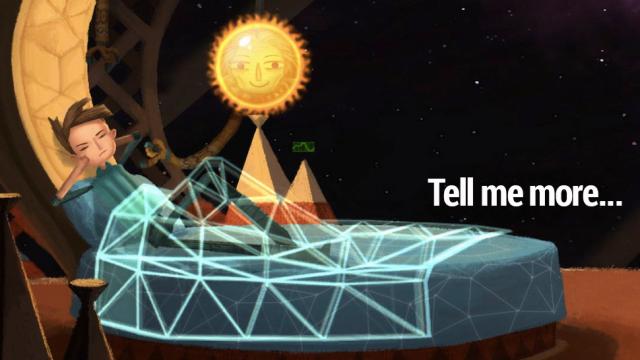
Comments
3 responses to “I Wish All Video Games Had Premises This Good”
I’m really glad to have read this article since the premise of Broken Age does sound very interesting and I really want to find out both Vella’s and Shay’s world and what happens to them.
It’s not that I had doubts on backing Double Fine’s adventure game on Kickstarter since having watched and read all the backers updates makes you kind of more excited to play the game. But it’s long hard slog waiting and waiting for the game to come out.
Sometimes, I don’t want to be spoiled by too much details, so when I do get to play the game, I’m going in with a kind of fresh naive open view of the game and story. However, impatience always gets the better of me and wanting to find out more and more makes it seem like the game is every closer to my twitching gaming hands! 🙂
I’m uh, not a fan of point and click games. at all.
Maybe it’s just because I’ve had exposure to a large number of storylines but the “Unwilling sacrifice defying tradition” and “Person with a comfortable life seeking real adventure” are fairly common starting tropes (Even in games), especially in fantasy and sci-fi. Of course, stories can always be distilled into a finite amount of themes and are more the sum of their parts so it’s where they go after that that’s the interesting part. Schaefer can also take something like “I want to be a pirate” and craft a brilliant and charming tale from it so I’m just hoping he doesn’t get lazy and follow the same paths that these storylines commonly take and instead, subverts the tropes out the wazoo. Part one can’t come soon enough, I need moar stories!